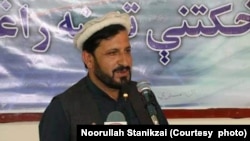Fifteen years ago, Noorullah Stanikzai returned to his home province of Logar to open a radio station broadcasting cultural and educational programs.
But the future of his station, Zinat FM, has seemed uncertain since the Taliban took power in August 2021.
“I am seriously considering closing the radio,” said Stanikzai, 48, adding that remaining open means having to work in a “challenging environment.”
“For now, the radio is operating, but we might not be able to continue for long. It is possible that today, tomorrow, or a month later, we close,” said Stanikzai.
Zinat FM is one of three local stations still broadcasting in Afghanistan’s Logar province, south of Kabul. But all of them face political and economic challenges, Stanikzai said.
“There is a ban on entertainment programs. We face serious economic problems,” he said. “Like other [private] media outlets [in Afghanistan], we can’t have political shows that we had before the Taliban, or criticize the authorities.”
It’s a pattern seen across Afghanistan, where Taliban restrictions on how media operate — including directives on how to cover certain issues, and bans on entertainment and women’s voices — has made journalism a difficult industry to navigate.
The media watchdog Reporters Without Border has said of the 543 media outlets working in Afghanistan before the Taliban takeover, only 312 remained three months later.
In December, the Taliban also banned FM radio broadcasts of Voice of America and Azadi Radio, which is part of VOA’s sister network Radio Free Europe/Radio Liberty.
Gul Mohammad Graan, president of the Afghan chapter of the South Asian Association of Reporters Club and Journalists Forum, told VOA that most of the people in Afghanistan do not have access to the internet, and most areas do not have electricity.
Because of that, he said, “radio is still the most popular medium in the country.”
Even with many stations shutting, “People still have access to radio channels and get their information on the current affairs in the country,” Graan said.
Broadcast changes
Before the Taliban takeover, Zinat FM was broadcasting around the clock, but now it has only 12-hour programming, Stanikzai said.
The situation used to be better for media, he said. “We had many political shows. We could criticize the government authorities, and access to information was better.”
Taliban officials have told journalists in Logar and other provinces that they have the right to cover any issue they want. But they are also warned not to air any news that would weaken the regime.
“Like other news outlets, we do not have the freedom to cover politics or criticize the government... though the Taliban say that ‘we support freedom of speech and press,’” said Stanikzai.
Journalists elsewhere in Afghanistan have said that the Taliban want the media to only air issues the group wants to be covered.
Another factor affecting broadcasts is the ban on all music, said Stanikzai. “They even want us not to air those radio transitions and commercials with music.”
“First, they told us orally that we should not air music or female voices. We requested an official statement. Then they sent us an official notice not to air music and women’s voices,” he said.
Limited programming, decreased revenue
With many issues now off limits, Stanikzai’s station mostly broadcasts educational, health, and religious programs.
But he said, those shows, especially on education, are needed now more than ever as girls are barred from going to school.
Because of the political and economic problems — advertising revenue has sharply declined — Stanikzai’s radio station lost eight employees, including two women.
“We run the radio with only four people,” said Stanikzai. “We were paying about $200 to $250 a month to an employee but now we are paying around $60.”
And while the station used to get around $175 to $235 for an advert broadcast twice a day, that has now dropped to $23 with the exchange rate.
But even with the shortfall, media outlets have to pay for electricity, a commercial license, and taxes.
“In the past, the government would help us. But, now, we have to pay,” he said.
A father of seven, Stanikzai said he has “lost hope" and sees "no future in journalism” in Afghanistan.
“I would probably go back to my village and start farming to feed my family,” he said.
This story originated in VOA’s Afghan service.















